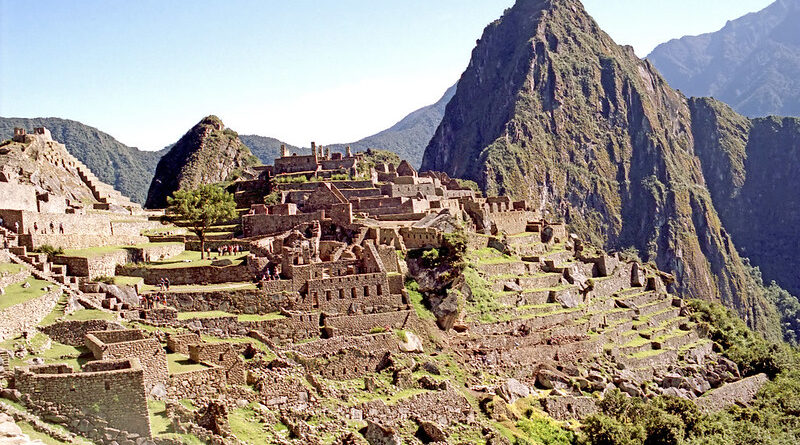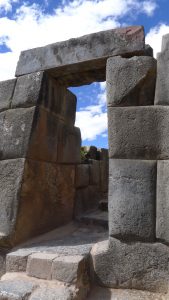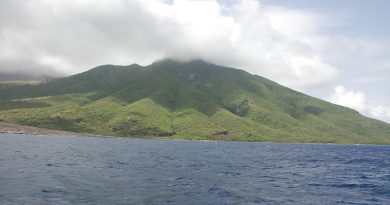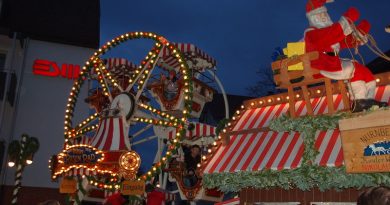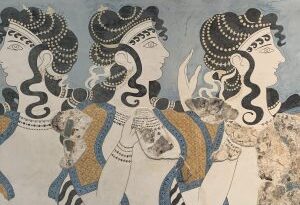The Inca Empire
The Inca were a civilisation which flourished from the 12th century until their conquest by the Spanish in 1533 in modern-day Peru and surrounding countries. With a centre in Cuzco in the Peruvian highlands, the Incas expanded into the largest pre-Columbian kingdom in the Americas, spreading across a diverse selection of climates such as the highlands of the Andes’ plateaus and jungles. Famous for their advanced technology, opulent and magnificent art and impressive architecture, the Inca were nonetheless undermined by their lack of military technology and resistance to European diseases.
1) Andes before the Inca
In the far north west of Argentina in the high and arid landscapes of the Andes bordering Bolivia, archaeologists have excavated pre-Hispanic ruins which were once home to indigenous people prior to the Inca Empire’s reign in the region and long before the arrival of the Spanish.Dozens of settlements have been found – like those at Quilmes and Tilcara, each having hosted several thousand people, known locally and collectively as the “Diaguita”.
These pre-Colombian tribes inhabited parts of Northwestern Argentina, Bolivia and Chile.
The region is famed for its picturesque multi-coloured rock formations, mountain cliffs, and fertile river valleys cutting through the dramatic landscape.
The descendants of the people who lived in ruined and lost settlements like Quilmes and Tilcara can be found today in towns such as Purmamarca and Humahuaca.
2) Cajamarca: Spanish vs. Incas
Cajamarca, now a small colonial city in the northern highlands of Peru, was once a major Incan city that played a pivotal role in the fate of the Inca; it was the site of the first contact between Pizarro’s conquistadors and the vast army of Inca Atahualpa. Thousands of Inca soldiers were slaughtered in that first fateful meeting, setting the scene for the long and bloody conquest that followed.
3) Machu Picchu
Machu Picchu is the most well-known, well-preserved and spectacularly located Inca archaeological site in Peru and therefore is the most visited. It was built around 1450, as the Incas spread their empire outwards from the capital Cusco, led by their visionary leader Pachacuti Inca Yupanqui.
The sheer scale of the site, the immense size of the stones and the rather inaccessible location are all testaments to the remarkable ingenuity, ambition and man-power displayed by the empire in creating such a lavish and durable complex in the clouds. Huge stones are perfectly pieced together without mortar like giant jigsaws, whilst large agricultural terraces wrap improbably around steep mountainsides. Within this former royal palace-cum-ancient citadel we find areas dedicated to sacrificial ceremonies, astronomical observations, worshipping of the sun god Inti, large-scale food storage and even prisons.
4) Pisac
Situated at a strategic position on a hilltop at the eastern end of the Sacred Valley is the Inca fortress town of Pisac. The site overlooks a deep gorge, with large terracing wrapping around the mountainsides and forming memorable vistas of the surrounding valley. Among the most important structures in Pisac are the royal baths complex, the Temple of Sun, the Temple of Heaven, military stations and areas dedicated to astronomy and sacrifices. These remains and the obvious agricultural activities hint at the scale, usage and importance of the town in Inca times, before it was destroyed by the Spanish in the 16th century.
5) Ollantaytambo
Ollantaytambo existed in part as an imperial retreat, as well as an administrative centre, a fortress and a small city of around 1,000 inhabitants. It was established relatively late on in the Inca empire, overlooking an important road from Cusco to Machu Picchu and near the confluence of the Urubamba and Patakancha rivers. The site was comprised of immense terraces, which provided protection for the fort, royal bathing quarters and a fine example of a temple dedicated to Inti, which was still being built when the first wave of Spanish arrived.
Ollantaytambo is notable as the scene of one of the Inca’s greatest victories against the invaders, though the city was eventually defeated in 1537. When the Incas were forced to flee from Ollantaytambo, it is believed that their decision to head to Victos and then the fortified Vilcabamba and not to Machu Picchu meant that the latter would not be discovered by the Europeans.Today Ollantaytambo is a small town which still preserves its largely traditional and agricultural way of life.
6) Moray
A rare example of elliptical terracing, Moray demonstrates an aptitude for finding ingenious ways to feed the immense Inca population. The terracing enabled different crops to grow and thrive at differing levels, altering the degrees of shade and sun and subtly varying the altitude.
A great deal of mystery and intrigue still surrounds the terracing, with the general consensus amongst experts being that they were used as a laboratory or research tool for different types of crops. This is backed-up by the evidence of soil from other areas of the surrounding Andean valley, having been imported to the site for testing. Thus the decision about which crops to grow in different climatic conditions and elevations around the Sacred Valley might have been taken here.
7) Sacsayhuaman
Forming the head of Cusco’s puma-shaped layout is the imposing temple-fortress
of Sacsayhuaman, built in the mid-15th century under the instruction of Pachacuti Inca Yupanqui. It is at once an imposing show of power and a structure designed to gracefully imitate and blend subtly into the surrounding landscape, best evidenced in the zig-zagging walls which mimic the curves of the mountains. It was used to both celebrate deities with sacrificial offerings and store masses of arsenal with which to defend the city from potential threats.
Sacsayhuaman was largely dedicated to the worship of Inti, the Inca sun god. At its heart is an unusual circular stone temple and the site was the scene for regular sacrifices and the annual Inti Raymi festival.
Held every June to mark the winter solstice, the Festival of the Sun endures to this day, a colourful affair with traditionally-dressed participants re-enacting ceremonial procedures and dances.
Just like Machu Picchu and many other Inca sites, Sacsayhuaman was an immense undertaking. Although a great deal of the structure was destroyed by the Spanish and its stones repurposed to build Cusco’s colonial churches, its vast walls preserve one of the finest examples of the precision and the craftsmanship with which the Incas constructed their fortresses and cities, as well as the emphasis placed on harmonious integration with the landscape.
8) Qoricancha
Once a richly gilded temple dedicated to Inti, Qoricancha was the most sacred and precious temple and pilgrimage destination in the entire Inca empire. Rebuilt under the guidance of leader Pachacuti Inca Yupanqui, it was supposedly inspired by the megalithic stone structures of the preceding Tiwanaku civilisation. From here, a series of ceques radiated outwards, sacred paths used for religious processions, land regulation and linking together shrines.
Inside Qoricancha lived around 4,000 priests, alongside the mummified remains of some of the most venerated Inca rulers.
The priests have long since departed and Qoricancha was quickly stripped of its precious gold and much of it destroyed. In its place today stands the colonial era Santo Domingo church and convent, the most vivid example of how Inca beliefs were ruthlessly supplanted with those of the Europeans. However, small parts of the original structure remain, including some of the trapezoidal walls of the sacred temple. The church itself is also one of the most impressive in Cusco.
9) Tipon
A number of smaller and lesser-visited Inca archaeological sites are dotted around the Andean countryside just outside of Cusco. These include the ‘red fort’ of Puca Pucara, the sacred puma-shaped hueca stone of Qenko and the sacred fountains of Tambomachay.
Water also plays an important role in the ruins of Tipon, less than 20 miles from Cusco. Believed to have served as a walled royal complex and gardens, the site displays an elaborate water channelling, reservoir and irrigation system. It is rightfully considered to be one of the most architecturally appealing ruins in the Sacred Valley region, helped in no small part by the soothing presence of water running throughout.
Tipon is also often associated with one of Peru’s most famous and unusual delicacies – cuy, more commonly known to you or me as guinea pig.
10) Raqchi
South from Cusco towards the sacred waters of Lake Titicaca is Raqchi, one of Peru’s lesser- visited archaeological sites. At its heart was a magnificent 15th century temple dedicated to the all-powerful creator god Viracocha. Today, the central wall of this structure remains, standing tall at 12 metres high and stretching some 92 metres long. The stone, mud and adobe wall gives a clear indication of the majesty and scale of the temple, thought to have been enclosed by the largest roof in the Inca empire.
Aside from the temple, Raqchi shows vestiges of its other functions, including ceremonial baths, administrative centres, imperial housing and perhaps even military barracks. It was also thought to have been an important tambo resting place on the road to Lake Titicaca.
11) Tombs of the Mummies
Juanita was found on the top of Mt Ampato in 1995. At the time it was a monumental discovery and made headlines worldwide as she was perfectly preserved due to the continual icy conditions since her death over 500 years ago.
Juanita was sacrificed on the mountain sometime between 1450 and 1480. She was approx. 11-15 years old. Her head was adorned with a cap made from the feathers of a red macaw, and she wore a colourful woollen alpaca shawl fastened with a silver clasp. She was fully clothed in garments resembling the finest textiles from the Inca capital city of Cuzco. This, in addition to evidence of excellent health, suggests that she may have come from a noble Cuzco family.
Juanita was a human sacrifice in the Inca capa cocha. – It is thought that she was killed by blunt trauma to the head: her cracked right eye socket and the two-inch fracture in her skull are injuries “typical of someone who has been hit by a baseball bat.” – The blow caused a massive haemorrhage, filling her skull with blood and pushing her brain to one side.
It would have been very difficult to carry her up the mountain when she was already dead and it is thought that she would have walked hundreds of miles, knowing she was walking to her death.
Juanita wasn’t the only sacrificial victim to be found in the mountains around Arequipa. Six additional frozen mummies of people sacrificed to Inca gods more than 500 years ago were more recently found on El Misti, Arequipa’s most dominant sight on the horizon.
Salta’s Museum of High Altitude Archaeology has an extraordinary display of the best preserved mummies in the world. The Lulliallaco Children were sacrificed to the Gods in an Inca ceremony over 500 years ago but they seem almost alive in the museum’s cryogenic display cabinets.
BACKGROUND
The Incas were a civilisation which flourished from the 12th century until their conquest by the Spanish in 1533 in modern-day Peru and spreading to surrounding countries. With a centre in Cuzco in the Peruvian highlands, the Incas expanded into the largest pre-Columbian kingdom in the Americas, spreading across a diverse selection of climates such as the highlands of the Andes, plateaus and jungles. Famous for their advanced technology, opulent and magnificent art and impressive architecture, the Incas were nonetheless undermined by their lack of military technology and resistance to European diseases.
Origin
According to Inca beliefs, in the beginning, Viracocha came out of the Pacific Ocean and created the Sun and all ethnicities of people, who were buried in the Earth to emerge later. The Incas specifically were spawned first as Manco Capac and his sister (and wife) Mama Oqllu, followed by three more sibling pairs. In one legend, these were spawned as children of Viracocha, in another as children of the Sun god, Inti. In either case, the Incas saw themselves as special, the chosen representatives of either deity on Earth and hence destined to rule. The different legends could be explained by the fact that commoners could not utter the name of Viracocha.
There are also different legends about where the first Incas spawned. The earliest says they spawned from a cave at Tampu T’oqo or ‘The House of Windows’, which was located at Pacariqtambo, south of Cuzco. However, in another the Incas emerged from the waters of Lake Titicaca onto the shore at Tiwanaku. This was a large but abandoned earlier Andean settlement in Bolivia, thought by the Incas to have been built by giants but who were later destroyed in a flood sent by Viracocha. This later myth may have been a way to link the Incas to the mysterious city and to bring the powerful local Aymara tribes under their control.
The siblings then set off with a golden staff, having been instructed to build a temple of the Sun where it sank into the ground. On the way, Manco Capac’s brothers die, in most stories killed by Maco Capac, before they reach Cuzco and here set up their capital.
Before the Incas
The Incas were only the latest in a series of Andean civilisations. Cuzco seems from archaeology to have been settled since possibly 4500 BC but was not important until the rise of the Incas in the 12th century. Before this, there were two major civilisations, that of Tiwanaku (300-c.1000 AD) and the Wari (600-c.1100AD), with Cuzco located quite centrally between the two. The Moche civilisation preceded even these two.
One of the reasons for the Incas’ success is thought to have been the pre-existing infrastructures and practices of these previous civilisations. Roads, hydraulic systems, and the agriculture of these civilisations were already in practice and were used by the Incas. As were their administrative practices, which involved creating several colonies and then integrating foreign settlements in between by keeping the local ruling systems but including them under their own administration. Non-reciprocal labour was also demanded as a form of tribute which explains how the colossal site of Tiwanaku could be created. The Incas both adopted the process of this labour tribute, and were inspired by the achievements of these former civilisations.
Cuzco
Cuzco was originally inhabited by the Killke people from 900-1200 AD who established the Sacsayhuaman, a fortress on the edge of Cuzco.
The Incas then incorporated this into the wider city of Cuzco, mostly under the reign of the Pachacuti, supposedly laid out in the shape of a puma, although some scholars believe this to be metaphorical. The Saksaywaman, with its own temple, road and aqueduct system, made up the head of the puma, and the imperial metropolis of Pumachupan made up the tail.
At its peak, the city may have had a population of 150,000. It was split into two main plazas, supposedly between the fore and hind legs, from each of which sprung two highways, extending to the four imperial quarters of the empire, called suyus. The wealth of the city was famous: it was dominated by the Coricancha complex (Temple of the Sun). The greatest temples were built to Inti, covered in 700 2kg sheets of gold, and to Mama Kilya, covered similarly in silver. There were also vast systems of parks, canals, irrigation, temples and fountains but most is now lost and remains only in the account of the Spanish and other European eye-witnesses.
Expansion
Pachacuti is often credited as the first great ruler of the Incas, reorganising the small city kingdom into an empire. Pachacuti was the second-born son but earnt his succession to the throne when in 1438 he defended Cuzco from an army of the invading Chanka tribe, supposedly 40,000 strong, whilst his father and elder brother fled. Upon succeeding to the throne, Pachacuti continued the war against the Chanka, defeating them and the Collao.
The son of the king traditionally led the army, and Pachacuti appointed his son, Thupa Inca Yupanqui, as head of the army in 1463, who succeeded his father as king in 1471. He is credited with having expanded the empire by a massive 4,000 km (2,500 miles). His greatest victory was against the Chimor on the North-West Coast of modern Peru, the last remaining rivals to the Incas, but he also expanded south into modern Chile and Argentina. Succession proved a great issue, as Thupa died with 2 legitimate sons and 90 illegitimate children. He initially favoured the son of one wife, but then decided on his other son, who would become emperor Huayna Capac. This caused the first wife to poison him, resulting in her and her son’s death after Huayna’s accession.
Civil War
Huayana ruled over the peak of the Inca Empire, expanding further south into Chile and Argentina, and north into Ecuador and Colombia, most importantly absorbing Quito in Ecuador by marriage to its queen. But the symptoms of the Incas’ fall began to become apparent: Huayana died in c.1524, many suspect from a European disease, spreading from the first Spanish Conquistadors in Central America, against which the Incas had no immune defence and so died in their thousands.
Succession also proved an issue as Huayana split his empire in two between his two sons: the North and Quito to Atahualpa and the South and Cuzco to Húascar. Peace lasted for 5 years despite rivalry before Húascar gained the favour of the Canari tribe, a powerful group in the Northern Empire who resented Atahualpa. Civil war ensued in 1529 in which Atahualpa was initially defeated and captured, losing an ear in captivity, before escaping. Bitter war continued with several cities razed to the ground and many leading Incas tortured and executed. But Atahualpa’s favour with his father’s generals turned the tide, as he gradually pushed south and captured Cuzco. However, Atahualpa stayed behind the front line and consulted the oracle of the Huaca Catequil, who prophesied that Atahualpa’s advance would end poorly. And just at this moment, the Spanish began their encroachment into Inca territory.
Spanish Invasion and Collapse
Francesco Pizarro had obtained permission from King Charles I and Queen Isabel of Spain to launch a conquest of what was known as Peru and marched into Incan territory in 1532 with a force of just 110-foot soldiers, 67 cavalry. Atahualpa agreed to meet Pizarro near Cajamarco in what is now the Inca baths. Atahualpa refused to become a Christian and tributary of Spain, not fearing the small Spanish force having brought 6,000 of his 80,000 strong army. However, Pizarro had planned an ambush hiding cavalry, musketeers and artillery in nearby buildings, technology the Incas had never faced and had no defence against. Pizarro launched and succeeded in his ambush, capturing Atahualpa. Atahualpa offered to fill the room he was imprisoned in with gold and twice that amount of silver, which he duly did, treasures being shipped from throughout the empire. However, Pizarro broke his word, eventually executing Atahualpa for treason against Spain and the assassination of his brother.
In the meantime, the war continued. Most of the Incan forces and the best generals were to the south near Cuzco, finishing the Civil War – a grave disadvantage. The Spanish armour and weapons were also a great advantage but defeat for the Incas was not inevitable. Pizarro could not be reinforced due to rebellion in Mexico and what was the Aztec Empire. He was forced to ally himself to local tribes, such as the Wanka tribe, who resented Inca rule. The Incas also failed to use guerrilla warfare as the Mapuche in the Amazon would successfully hold off the Spanish with. Finally, European diseases, such as smallpox and typhus, wiped out thousands of the native South Americans, spelling their downfall.
The Last Incas
In 1533, Atahualpa’s brother Manco Inca Yupanqui was installed as king and for a time cooperated with the Spanish before retaking Cuzco. He resisted four counter-attacks and killed 500 Spanish before being forced out of the city. He retreated to the remote mountain jungles of Vilcabamba and set up the ‘Neo-Inca’ state.
Here the Incas adopted some Spanish weaponry and tactics, especially crossbows and cavalry. The new state lasted for 36 years before an incident on the border caused the death of two Spanish ambassadors, triggering the final Spanish invasion in 1572. Despite spirited resistance, the Incas could not break the siege and abandoned their final cities, retreating to the jungle.
The final king, Tupac Amaru, was found and executed. The remaining Incas were forced into labour for the Spanish, with one male from each family being forced to mine precious metals. Such men usually died after a year or two, and another male was expected to replace them. Moreover, disease outbreaks such as typhus in 1546, smallpox in 1558-9, diptheria in 1614 and measles in 1618 killed many.
Government
The Inca empire was known as the Tahuantinsuyu, which consisted of an administrative centre of Cuzco, with four highways leading to four provincial suyus: Chinchasuyu (NW), Antisuyu (NE), Kuntisuyu (SW) and Qullasuyu (SE).
The Inca king (Sapa Inca) was the centre of the Empire. Supposedly he drank from gold and silver cups, wore silver shoes, and living in a palace furnished with the finest textiles. The Incas also mummified their rulers and stored them in the Coricancha temple in Cuzco. These were sometimes brought outside, especially in November, ‘the month of the dead’, wearing their finest regalia. They were given offerings of their favourite food and drink, and ‘consulted’ for their opinion on pressing state affairs.
The Incas had no laws but three moral principles: Ama sua: Do not steal; Ama llulla: Do not lie; Ama quella: Do not be lazy. The Incas achieved great success by not conquering local tribes but indoctrinating them and allowing their local elites to continue ruling. However, the families of these elites were often held as hostages and the most important roles were reserved for Incas. Colonies were also dotted through the empire to ensure Inca control and garrisons throughout. The Incas used no currency, so tribute existed either in the form of labour or in the mode of goods such as textiles and luxury items.
Language
Quecha was the official language of the Incan Empire. It was not only an Incan language but existed before in many areas and was indoctrinated in all conquered territories. Special privileges were given to those who could speak the language. However, regional dialects were maintained and some areas maintained their own language such as Aymara, still spoken in Bolivia. Quecha is in fact still spoken by over 8 million people.
Social
At its peak the Incan empire contained nearly 12 million people. Most were farmers and existed in agricultural communities but the Spanish were greatly impressed by the Incan cities. Eyewitnesses described that they were as large as European cities but generally more pleasant to live in, for the road and water systems were superior in South America to Europe.
The Incas divided their lives up into various stages. Until 3, children were known as wawa, a near void description given the common infant mortality rate. At 3, a ceremony occurred where a child was welcomed into life; the whole family would be invited and given a lock of the child’s hair before it was shaved. The child was now warma, a stage of ignorance, before reaching 14 and the first stage of puberty and gender realisation.
The Incas had strong but equal gender roles. Boys’ coming-of-age ceremonies included dancing, fasting, and tasks to display strength. Girls’ main ceremony was the onset of menstruation, upon which they would go into the forest until the bleeding stopped. Both would then be given new clothes and taught how to live as a man or woman. A ‘folly’ stage then occurred, allowing sex without being a parent, before marriage and full maturity. Old age was described as a decline, particularly the final phase of Ruku, or decrepitude from the age of 90.
The Incas were uniquely adapted to high altitude: slower heart rate, high lung volume, and larger haemoglobin amounts to transfer oxygen. Incan nobility also adopted the practice of wrapping the heads of new-born in tight fabric to mould their heads into conical shapes, designed to set them apart as nobility.
Religion
Religion was of great importance to the Incas and strongly linked with the movement of the constellations as seen from Cuzco, thought to be the centre of the world. These were normally observed in special sanctuaries, huacas, positioned in spectacular places. The most important deities were Inti, the sun god, and Viracocha, the creator god. On Lake Titicaca there was an island temple devoted to Inti. But the Incan pantheon was vast, and adopted many foreign deities as their own, as well as allowing the worship of local religions in conquered territories. One such example was the scared city of Pachacamac, named after a god of the same name, with a wooden statue considered to be an oracle, which attracted many visitors.
The Incas believed in reincarnation in another world and so the worship of ancestors was of great importance. It was important that no body was burnt, as this would destroy their vital force. The ancient sites of previous civilisations, particularly Tiwanaku, were head in special reverence. Mummies were also frequently displayed and ‘fed’, either with food or libations of chicha beer, as part of ancestor worship. The most gruesome form of worship was sacrifice, particularly human sacrifice. 4,000 servants and officials were supposedly sacrificed upon the death of Huayna Capac in 1527. In 1999, archaeologists in Argentina even found the remains of three sacrificed children in a huaca on a volcano, specially fed maize and dried llama meat and drugged with coca leaves and alcohol.
Science and Technology
The Incas were an advanced civilisation, especially given the lack of a written language. In place of this, they developed the Quipu knot system. A series of differently coloured and lengthed string would hang from a wooden bar, with knots tied at different heights. Sometimes the ropes were interwoven, with larger quipus containing as many as 1500 ropes, suggesting a great complexity of meaning some scholars suggest as an alternative to written text. How to interpret these quipus has sadly been lost and will remain a mystery.
The Inca also made impressive medical discoveries, achieving 80-90% survival rate in skull surgery and using coca leaves as anaesthetic, lessen hunger and give energy.
Art
Inca art is most evident in luxury items. Precious metals were beautifully worked to mark their near divine status – gold as sweat of the sun, silver as tears of the moon. However, textiles, especially cumpi, made of alpaca or vicuna wool and cotton, or sometimes more exotic materials such as bat hair or hummingbird down, were the prize items. Designs often used repeated geometric patterns, such as chequer boards, and often special designs designated specific ethnicities to mark out their tributary contributions.
Architecture
Incan architecture was their most impressive development. Without using any mortar, the Incas were able to build large buildings in extraordinary locations, by incorporating the natural landscape and using stones that were cut to perfectly fit together. One scholar even wrote a razor blade could not be fit between. As a result, many structures still remain despite the frequency of earthquakes in the region, most spectacularly at Machu Picchu, a mountain citadel most commonly thought to have been built as an estate for Pachacuti.
The most common buildings were qollqa, one room warehouses to store potatoes and other foodstuffs. One major cause of Incan success was their ability to store potatoes, freeze-dried in the freezing outdoor night-time conditions and then stored in such qollqa. Most buildings were one room, with the kancha the most normal dwelling: a single room with a thatched roof. Terraces were also developed as a key part of Incan architecture as way of farming in the steep Andes.
But the most vital building of the Incas were roads which spanned across the empire and transported messengers with great speed, as well as llama caravans. Some estimates state the road system consisted of almost 25,000 miles of road – three times the Earth’s diameter.
Conclusion
The Incas were a spectacular and advanced civilisation that dazzled even the Spanish explorers who conquered them. Even with their fall, their influence carries on today in their art, monuments and language which still survive as a key part of Peruvian and South American identity.
More information:
Download: Bazaar – Peru
Read: Horsetrekking the Inca Trail
Read: The Andes Before The Incas
By Wilfred Sandwell

